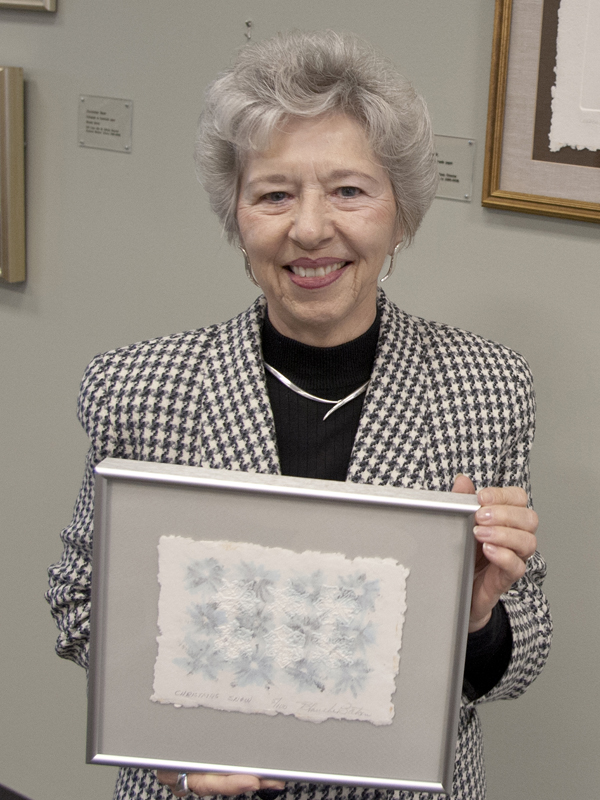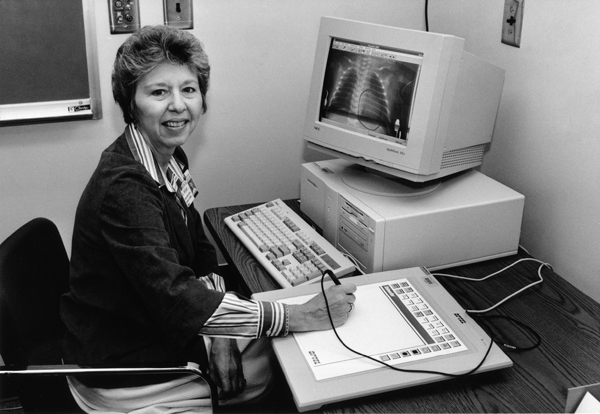Art donation is one for the books

For more than two decades at UMMC, Ada Seltzer made the Rowland Medical Library hospitable to everyone from computer users to coffee lovers.
Her mission was to ensure that the library remained relevant and welcoming; and now, six years after retiring, she’s still at it.
Seltzer, who gave the Medical Center more than 20 years of her life, has given it some of her art, donating four works by paper sculptor Blanche Batson.
“I believe they belong here,” Seltzer said.
They belong because Batson was a renowned Mississippi artist; because she’s the late wife of Dr. Blair Batson, a Medical Center icon; because Seltzer knew and admired her; and because Seltzer remains devoted to the institution that recruited her almost 30 years ago.
The framed creations – representing snow, trees, a hawk and an open umbrella – hang in the building where Seltzer practiced her own kind of art.
“My profession gives you tremendous emotional rewards,” said Seltzer, who lives in the Rankin County Reservoir area. “You help people find what they want.”
Seltzer found what she wanted at the Medical Center, beginning Dec. 1, 1986, her first official day as director of the vast repository of textbooks and paper documents that was about to be vanquished by computers.
“It was a career move coming here,” said Seltzer, a Kutztown, Pa., native who had left a similar position at the University of South Florida.
“I was able to do some things professionally in Mississippi that I wouldn’t have been able to do elsewhere.”
Dr. Norman Nelson, vice chancellor at the time, sought a replacement for Irene Graham, the library’s first and, until Seltzer, only director.
“When Irene retired, computer technology was just getting going in the academic world,” said Barbara Austin, former director of public affairs.
“Dr. Nelson saw the need to computerize the library, and searched for a director with excellent computers skills; that’s what he found in Ada.”
Medical students also found an advocate.

“She was a tireless champion for moving us into the modern-day world of electronic resources,” said Dr. LouAnn Woodward, associate vice chancellor for health affairs and vice dean of the School of Medicine.
“She was also the person who opened the door to allow students to bring in covered drinks – a major change from our longstanding rule of no food or drink in the library. For them, this was a huge and important issue.”
Seltzer was a major door opener. Under her leadership, the library’s knowledge become easier for students to tap into.
“Medical students, interns and residents needed access to the materials all the time, even when they were off-campus,” said Dr. Bill Lushbaugh, professor of microbiology. The online database Seltzer established gave them that access, he said.
Because of her work, he said, “today, you can get almost anything you want on your laptop and about as fast as we can talk about it.”
Students can print documents from their laptops because of Seltzer, said Frank Acree, now a systems analyst intermediate, who set up the library’s computers during Seltzer’s tenure.
“The first place they could do that was in the library. It became campus-wide after she did it first.
“She was very devoted and passionate about keeping the library relevant to the university.” And to the state, especially when Hurricane Katrina struck in 2005.
“We kept the library open for other hospitals to use,” Acree said. “If doctors needed to look up something, Ada made sure they could. We were the state’s medical library.”
She was an innovator and a trend-spotter who played an important role in establishing the Evidence Based Medicine course, then a cutting-edge approach to teaching medical students, Woodward said.
“A number of other medical schools created similar programs modeled after ours.”

Seltzer also started the Mississippi Health Sciences Information Network, the first statewide online network of its kind connecting health providers throughout the state with national and international resources.
She designed training for students to do online searches, Acree said.
Her talents transcended her career, Woodward said. “She is an awesome, and award-winning, ballroom dancer.”
And she became devoted to collecting art, not only for herself, but also for the library. As director, she sustained Graham’s and Austin’s legacy of acquiring works by Mississippi artists, a tradition embraced by Seltzer’s successor, Susan B. Clark.
It was at the Chimneyville Crafts Festival that Seltzer met the woman who would become one of her favorite artists. A native of Roseland, La., who grew up in Magnolia, Batson taught art at Southeastern Louisiana University for years before returning in 1976 to Mississippi, where she married Dr. Blair Batson.
She made her own paper in her studio, creating inventive paper sculptures that have been viewed everywhere from the Mississippi Governor’s Mansion to Washington, D.C., as part of an exhibit titled “Mississippi: A Sense of Place.”
“Blanche Batson had a tremendous spirit,” Seltzer said. “I started collecting her art, especially her nature scenes.”
Throughout her retirement, Seltzer has supported the medical library through annual giving, and she intends to expand her sponsorship through her estate plan. Her latest gifts are on view on the library’s lower floor – archivally preserved collographs, or collagraphs: prints made from a collage.
One of her favorite works is the open umbrella, an iconic Batson piece and a symbol of Seltzer’s conviction that the library should be a haven for students.


